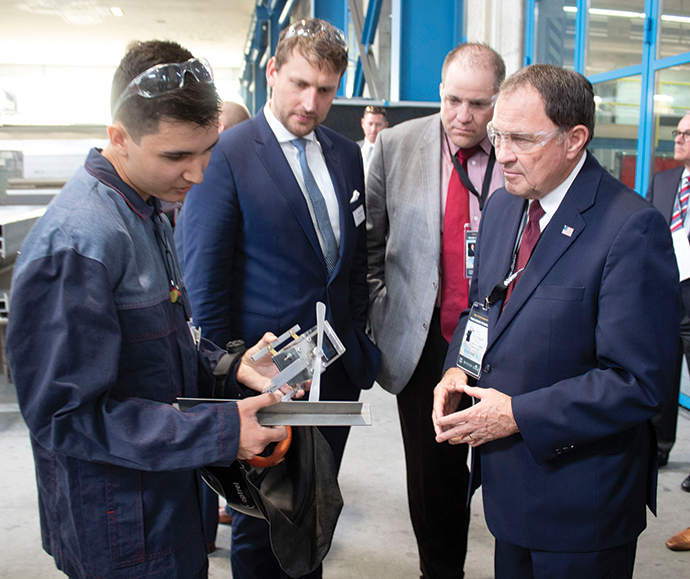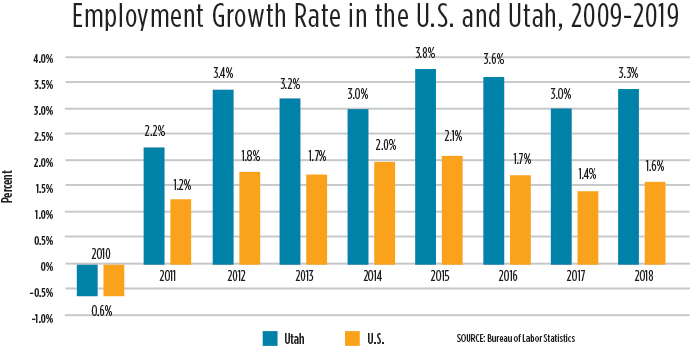Gary Herbert took office as the 17th governor of Utah in August 2009, a time of national and statewide gloom. With the Great Recession at its apex, Utah’s unemployment rate was eclipsing 8%, with job growth stagnant. The state’s Rainy Day Fund had shrunk to a worrisome $200 million. But new Governor Herbert saw sunshine on the horizon.
“Utah,” he famously told a gathering of business and community leaders, “will lead the nation as the best performing economy and be recognized as a premier global business destination.”
The reaction was one of amazement.
“I remember thinking, ‘Well, that’s a really ambitious goal,’ ” says Phil Dean, now State Budget Director and Chief Economist with the Governor’s Office of Management and Budget. “I was among those who really wasn’t sure we could do it, but I was glad that he was putting it out there. Ten years later,” Dean says, “it’s been remarkable to see that it’s happened under the governor’s leadership.”
As Gov. Herbert prepares to leave office in January, evidence tells the story of Utah’s amazing turnaround: In Dec. 2019, The Wall Street Journal named Utah “America’s economic star.” Utah consistently ranks as the No. 1 state for private-sector job growth. For a decade, Forbes has ranked Utah a top-three Best State for business, including six times at the No. 1 spot.
Moreover, Utah’s export growth rate has been the highest in the country over the past two years. The state’s formerly anemic Rainy Day Fund tops $900 million. And Utah maintains a AAA credit rating from Moody’s, S&P and Fitch.
Major project wins under Herbert like Northrop Grumman, Tyson Foods, Goldman Sachs, Facebook, Stadler Rail, Adobe and PayPal demonstrate how word has spread among business leaders: Utah wants you.
“We are the most business-friendly state in America,” Herbert tells Site Selection. “We want to keep government off your backs and out of your wallets.”
That, in a nutshell, is it. Seattle native Alex Bean, co-founder and CBO of Divvy, a high-flying financial tech startup based in Salt Lake City, has seen how it works up close.
“We can do everything in our power to build a successful business here, because we know the government’s not going to try to come in and undercut us at the last minute,” Bean says.
“We can go out there and be aggressive and put our foot on the gas.”
Says Herbert: “We’ve had a significant effort to eliminate nonsensical regulations. We want to enable wealth creators and risk takers. We want to give them the ability to innovate and find niches in the marketplace.”
That’s a message heard loud and clear from Logan in the north to booming St. George in the south, ranked the nation’s eighth-fastest growing city by WalletHub.
“Our experience in Utah is that everyone at all levels of government is working to help us do business,” says Mike Williams, president of defense contractor Kihomac, which manufactures equipment for the Pentagon at its facility in Layton, just east of sprawling Hill AFB. “Kihomac is a great example of how a company can thrive in Utah.”
The Cheerleader
A low-key leader not prone to hogging the spotlight, Herbert is nonetheless endowed with remarkable gifts of salesmanship and persuasion.
“He calls himself the chief bragging officer,” says Val Hale, executive director of GOED, the Governor’s Office of Economic Development. “He’s travelled the country and the world promoting Utah, and he’s done a phenomenal job.”
Miles Hansen, president and CEO of World Trade Center Utah, has hopscotched the globe with Herbert in his role promoting the state’s international business interests. Herbert, Hansen says, has a knack for gaining the trust of leaders as varied as those of Qatar, Switzerland, Japan and Taiwan.
“Governor Herbert,” says Hansen, “recognizes the importance of relationships, and is very effective in using his international engagements at finding ways that Utah companies, organizations or institutions can be helpful when it comes to what the other side cares about. He’s shown himself to be an incredible partner.”

Top aides describe a leader who trusts his people, listens intently and can make the tough decisions.
“He’s a steady hand at the wheel. He hears every point of view, then digs in and does the hard work of problem solving,” says Vicki Varela, managing director of the Utah Office of Tourism.
Under Herbert’s leadership, Utah’s tourism industry has grown from something of an afterthought into a $10-billion-a-year juggernaut. It’s home to “the Greatest Snow on Earth” and “the Mighty Five,” the state’s unmatched collection of otherworldly National Parks.
Varela tells a story about the launch of the “Mighty Five” marketing campaign, whose much-anticipated rollout in 2013 nearly was derailed by a federal government shutdown that closed the National Parks.
“We’d been getting interest from all over the world, and then the shutdown hit. The Governor got on the phone with the Secretary of the Interior and told her we had to work something out. She allowed us to open the parks as long as we’d cover funding for bare-bones operations. We did that, and we ended up getting back many, many millions of dollars in economic benefit. We had other states calling, asking us how we did it.
“That,” says Varela, “is just one example of how Governor Herbert has his people’s backs. He recognized a problem, and he stepped up and said, ‘I’m gonna fix it.’ ”
Balance Lures Talent
Businesses have struggled to fill their workforce needs, a muscular, youthful, engaged talent base is another of Utah’s distinctions.
“The educational attainment of our workforce is exceedingly good,” says James A. Wood, Ivory-Boyer Fellow at the Kem C. Gardner Policy Institute and a long-time observer of the Utah economy.
“From 2010 through 2019, we have led the country in population growth. And we’re getting more and more in-migration. What that gives you is an abundant supply of quality labor,” Wood says.
“We have really, really smart people coming out of Brigham Young University and the University of Utah,” says Divvy’s Alex Bean. “They’re young, they’re energetic and they want to stay here. Businesses locate here because they know they can get great talent — development talent, sales talent, financial talent — and all for a lot less than they’d be paying in New York or Seattle.”
In 2016, a group of aerospace companies approached GOED, expressing concerns about a potential shortage of workers. Out of that meeting emerged Utah’s Aerospace Pathways program, which became the forerunner of Talent Ready Utah, an initiative designed to give head starts to high school students in careers that have come to include medical technology, life sciences, architecture engineering and construction, among others.
“Governor Herbert,” says Kimberlee Carlile, director of the Talent Ready Utah Center, “has been a champion of workforce development. He’s met with companies, listened to them and responded to their needs.”
Herbert is bullish on Utah workers.
“Most of our young people are going into post-high school education. We’re tech savvy. We have a labor force that is just what companies are looking for.”
Ask around and you’ll learn that Utah’s singular lifestyle, affordable and vibrant, is an unmatched draw for workers and their employers.
“Living in Salt Lake, I can take part in world-class skiing, mountain biking and golf and be in the office in 15 minutes, no traffic,” says Divvy’s Bean. “It’s my biggest reason for being here. There’s a unique balance, where people are committed to their professions, but really care about family life and recreation. You don’t work 20 hours a day like you do in New York or San Francisco.
“That,” says Bean, “is what’s come together to make this place a really attractive pro-business, pro-lifestyle environment. In terms of recruiting, that’s a very easy sell, especially when it comes to people who are tired of the city grind.”
Riding a Wave of Diversity
Once heavily dependent on mining, manufacturing and aerospace, Utah’s economy now boasts one of the country’s most dynamic and innovative technology clusters, along with high-growth sectors such as medical devices, financial services, e-commerce, energy, renewables and life sciences.
“We have the nation’s most diverse economy,” says Wood. “Having that diversity really helps when you’re looking at a recession.”
Recursion Pharma, a drug discovery company, is an up-and-coming member of Utah’s “Silicon Slopes,” the tight-knit tech community that includes such giants as Qualtrics, Domo, Lucid, Pluralsight and Podium. Brooke Clark, senior director of talent acquisition, says Recursion, founded in Salt Lake in 2013, now employs more than 170 people and has raised over $200 million in capital. She says the company has at least three new drugs in various stages of development.

“We’re poised to be a strong presence in Salt Lake City’s life sciences community,” says Clark. “We’re doing what we can to make room for others to make Salt Lake the next biotech hub.”
If Recursion is a relative newbie, Provo-based Qualtrics rests at the peak of the Silicon Slopes. Founded in 2002, Qualtrics recently was acquired for a near-record $8 billion by Germany-based software giant SAP.
Ryan Smith, Qualtrics co-founder and CEO, enjoys cult-like status among Utah’s tech community. He’s seen it all from the start, and he believes Gov. Herbert’s support has served as fuel to help propel the community to stardom.
“He just shows up,” says Smith. “He shows up in every office, shows up for every announcement. He just makes time for business.
“What you need to understand about Utah,” Smith confides, “is that it’s a can-do culture. It’s an underdog culture where people want to swing for the fences. When you look at what our tech community’s accomplished, we probably don’t have much business doing it, but we do it. Why not?”
This Investment Profile was prepared under the auspices of the Utah Governor’s Office of Economic Development. For more information, contact Pete Codella at 801-538-8774, or by email at pcodella@utah.gov. On the web, go to business.utah.gov.

